Learn how to use 15 Candida diet sweeteners for both cleanse and reintroduction phase.
I’ve seen that what puts people off the most when it comes to starting Candida cleanse is finding a good sugar substitute. In this article I’ll introduce you to 10 sweeteners you can use while on Candida cleanse and 5 more for when you start reintroducing foods.
Download FREE Guide to Candida Overgrowth
In case you prefer watching and listening to reading, you’re welcome to watch the below video:
Table of contents
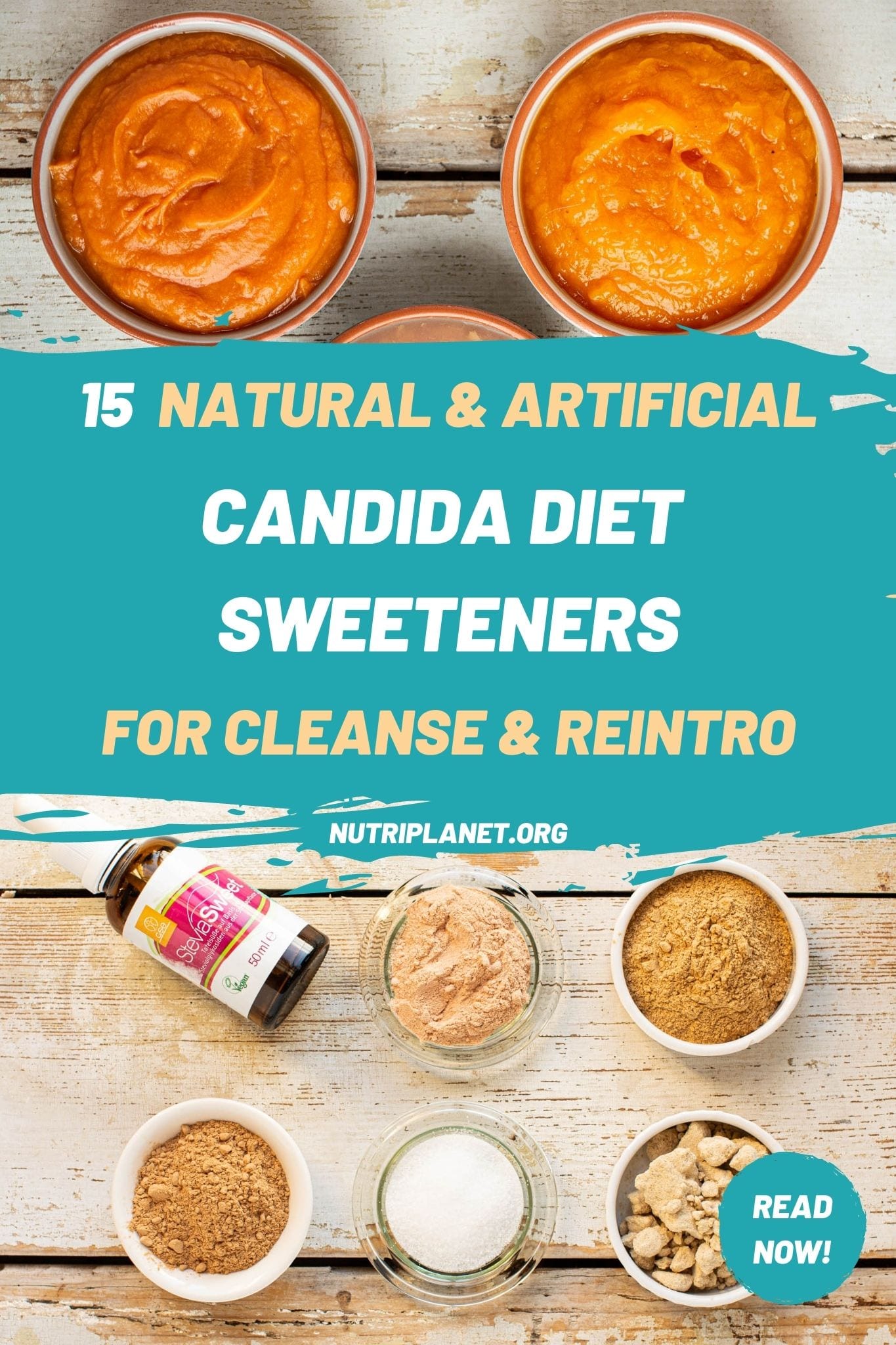
15 Candida Diet Sweeteners
Fortunately, you still can taste the sweet side of life, even when on Candida diet. So let’s start with the sweeteners for Candida cleanse diet.
10 Sweeteners for Candida Cleanse
1. Almond and Coconut Butter
These are the only whole food Candida cleanse sweetener that I can think of. Of course, if you’re just coming off sugar, you might not understand how almond butter can even be considered as sweetener. However, give yourself a few weeks and almonds will actually taste sweet to you!
Use almond butter and coconut puree for baking, in porridges, smoothies and desserts.
P.S. You can start thinking of cashews and peanuts as well once the cleanse phase is over. In my opinion, cashew butter is particularly sweet.
Fortunately, we have a whole list of almost whole food Candida diet sweeteners. Almost because water has been removed from the following sweet powders. However, there’re still vitamins, minerals and most importantly fibre!
2. Carob Powder
The first powder is made from the dried pods of the carob tree. One of the benefits of carob powder is that it’s a caffeine-free ingredient that can be used as a replacement for cacao powder in brownies, cookies, cakes and smoothies.
It’s noteworthy that carob is less bitter than chocolate and has a roasted, naturally sweet flavour. For this reason my carob chips are made without added sugar.
Be aware that there is also roasted carob powder which tastes very bitter and cannot be used as sweetener. Therefore, when you order online make sure it’s light-coloured carob (unroasted or lightly roasted).
Is it healthy? According to Dr. Greger, it’s a green light food! Yeah! It can even protect human colon cells from DNA damage. [1]
How to use carob
The use of carob is almost identical to mesquite powder. However, carob is more versatile in a sense that you can make delicious chocolaty-looking bakes or desserts without the need to add any other sweeteners. This is how my healthy chocolate sauce and frosting are made. Not to mention the usual porridges and dessert bowls.
More recipes with carob powder:
- Chocolate Bliss Balls
- Gingerbread Flavoured Energy Balls
- Vegan Paleo Brownies
- Chocolate Chip Cookies
Buy carob powder on amazon.com or amazon.co.uk [affiliate links]
3. Mesquite Flour
It’s a traditional native American food with a very low glycemic index and a high mineral content. Mesquite powder or flour is made from the leguminous seed pods of the drought-tolerant mesquite plant, also known as algarrobo.
Mesquite flour has a very pleasant sweet, caramelly and nutty taste.
How to use mesquite
I simply love it in my evening dessert bowl made of oats and chia seeds. Combined with either applesauce or mango puree, I do not need any other sweetener.
You can also add it into your oatmeal or other porridge. Over the years I’ve used mesquite any many recipes on my blog including cinnamon rolls, caramel sauce, lemon cake, blondies, cookies etc.
Buy mesquite flour on amazon.com or amazon.co.uk [affiliate links]
4. Yacon Powder
The next powder is a bit more rare than the previous ones. Smallanthus sonchifolius, derived from the yacon root, is a South American tuber that tastes like an apple. Its health boosting properties and taste have been appreciated in Peru and other South American cultures for centuries. Yacon has been enjoyed as a valuable health food because it contains prebiotics called inulin. The latter feeds the healthy bacteria (probiotics) in your gut.
Yacon powder is mildly sweet and has an aftertaste if you eat the pure powder. However, it’s not distinguishable when mixed into foods, i.e. porridge, cake/cookie batters etc.
How to use yacon powder
Definitely don’t use yacon in the drinks as it’s a powder. As with all the other powders, use it for baking or adding sweetness to desserts, smoothies and porridge bowls.
I found pure yacon powder only on amazon.co.uk [affiliate link]
5. Lucuma Powder
Lucuma is the fruit of the Pouteria lucuma tree native to South America. Nicknamed the “gold of the Incas,” lucuma has been used as a traditional remedy in South America for centuries. [2, 3]
Lucuma powder also offers a relatively good amount of both soluble and insoluble fibre. Insoluble fiber adds bulk to your stool and prevents constipation by helping food move smoothly through your gut. [4]
Soluble fiber feeds your beneficial gut bacteria, which, in turn, produce short-chain fatty acids (SCFAs) like acetate, propionate, and butyrate. These are then used as food by cells in your gut, keeping them healthy.
These short-chain fats also protect against inflammation and improve symptoms of gut disorders, including irritable bowel syndrome (IBS), Crohn’s disease, and ulcerative colitis. [5]
What’s more is that one tablespoon (7.5 grams) of lucuma powder provides some calcium, iron, potassium, niacin, and vitamin C — though these amounts generally cover less than 1% of the Daily Value (DV). Still, it’s more nutritious than other popular sweeteners.
Furthermore, lucuma contains a variety of antioxidants. The latter help protect your cells from damage caused by highly reactive molecules called free radicals.
Finally, lucuma is rich in complex carbs and fibre and may reduce your body’s ability to absorb simple sugars. This in turn may help prevent blood sugar spikes and regulate blood sugar levels. However, research in this area is limited.
How to use lucuma powder
Mix it into desserts, in baking, smoothies, nicecreams.
Buy lucuma powder on amazon.com or amazon.co.uk [affiliate links]
6. Monk Fruit Juice Powder
It is a natural low-calorie sugar alternative, derived from real monk fruit. Also known as Luo Han Guo, monk fruit is a small melon native to southeast Asia. The fruit is very sweet, due primarily to naturally occurring antioxidants known as mogrosides, which give a cleaner and more intense sweetness.
Be aware though – most sellers provide artificial sweeteners including monk fruit extract, which is absolutely not the same as dehydrated and ground monk fruit. Now, if it’s the real thing it’ll have 400 kcal and 1 gram of fibre per 100 grams of powder.
How to use monk fruit powder
It is being claimed to be 8 times sweeter than regular sugar. Unfortunately I can’t vouch for that as I haven’t tried it myself.
Use it in beverages, for baking or adding sweetness to desserts, smoothies, sauces, and porridge bowls.
Check out those products by Matakana Superfoods, West Point Naturals, and Nuts.com.
7. Plant Milks
The last of non-artificial Candida diet sweeteners are naturally sweet plant milks like oat milk and coconut milk. The latter actually being a whole food sweetener.
They are excellent for making chicory, matcha, chaga or turmeric lattes without the need to add any other sweetener.
One thing you need to make sure is that your milk comes with no added sugars!
Besides sweetening your warm drinks, make use of plant milks in oatmeal, dessert bowls, chia pudding and in baking.
Next, moving on to artificial Candida diet sweeteners.
8. Stevia
It is a sweetener and sugar substitute derived from the leaves of the plant species Stevia rebaudiana, native to Brazil and Paraguay. The active compounds are steviol glycosides, which have 30-150 times the sweetness of sugar. They are also heat-stable, pH-stable, and not fermentable.
However, steviocides, the active ingredients in stevia, are transformed into steviol by our intestinal bacteria (in colon) and this is toxic causing a big spike in mutagenic DNA damage.
How much stevia is safe?
The WHO considers up to 1.8mg of stevia compounds per pound of body weight to be safe amount (4mg per kg of body weight). In other words, drinking up to two stevia sweetened beverages a day should be considered harmless.
Stevia comes in 2 forms – dried and powdered stevia leaves and liquid stevia extract. While the first can be considered almost whole food, the latter is definitely a processed product.
How to use stevia
I’ve found I can’t have the dry powdered form as the aftertaste is simply too strong and unpleasant. However, the liquid from is very mellow. So I’ve used it in baking as well as some dessert and candy recipes. When using stevia always keep in mind the safe dosage though.
12 drops of liquid stevia = 1 tbsp of granulated sugar
Buy liquid stevia on amazon.com or amazon.co.uk [affiliate links]
Now moving on to sugar alcohols xylitol and erythritol.
9. Xylitol
It is a sugar alcohol, that is found in small amounts in many fruits and vegetables and is therefore considered natural. Since xylitol is still a refined sweetener, it doesn’t contain any vitamins, minerals or protein. In that sense, it provides only empty calories.
Xylitol looks and tastes like sugar but has fewer calories and doesn’t raise blood sugar levels.
Even though sugar alcohols are technically carbohydrates, most of them do not raise blood sugar levels and thereby don’t count as net carbs. The latter makes them popular sweeteners in low-carb products. [7, 8]
Even though the word “alcohol” is part of its name, it’s not the same alcohol that makes you drunk. On the contrary, sugar alcohols are safe for people with alcohol addictions.
NB! Be careful not to over consume as it may cause digestive ailments. Due to sugar alcohols’ unique chemical structure, your body can’t digest them. They therefore pass unchanged through most of your digestive system. When they reach the colon, they are fermented by the resident bacteria, which produce gas as a side product. Consequently, eating high amounts of sugar alcohols may cause bloating and digestive upset. Since xylitol is not absorbed it draws fluid into your colon and can have laxative effect.
Use xylitol exactly as you would use regular sugar. Check out my Candida diet recipes for ideas on how to use xylitol.
Buy xylitol on amazon.com or amazon.co.uk [affiliate links]
10. Erythritol
Like xylitol also erythritol belongs to a class of compounds called sugar alcohols. It has about 70% of the sweetness of sugar. In large-scale production, erythritol is created when a type of yeast ferments glucose from corn or wheat starch. [9, 10]
Is erythritol safe?
Overall, erythritol appears to be very safe. It’s because erythritol is different from the other sugar alcohols. Namely, most of it gets absorbed into the bloodstream before it reaches the colon. [11] In fact, about 90% of erythritol is excreted unchanged in the urine. [12]
According to Dr. Michael Greger’s standards erythritol was considered harmless. It’s because it’s found naturally in pears, melons and grapes and is absorbed in the intestines. So it doesn’t have a laxative effect. However, new research has been conducted and it can now even seen as helpful as it contains antioxidants. [13, 14]
However, eating high amounts may still cause digestive upset because the remaining 10% travels down to colon. In fact, one study showed that 50 grams of erythritol in a single dose increased nausea and stomach rumbling. [15]
However, feeding studies providing up to 0.45 grams per pound (1 gram per kg) of body weight show that it is very well tolerated. [16, 17]
So, unless you’re eating massive amounts at a time, you’re unlikely to get an upset stomach.
How to use erythritol?
Again, use as regular sugar. As it’s a bit less sweet than sugar you might need a larger quantity though, i.e. per every tablespoon, add an extra teaspoon.
Buy erythritol on amazon.com or amazon.co.uk [affiliate links]
The Safety of Artificial Sweeteners
When people were randomized into groups and were given drinks sweetened either with aspartame, straight sugar, stevia, or monk fruit sweetener, the 24h average blood sugar was more or less the same in all groups. How can this be? As it turns out, people in natural sweetener groups ate so much more for lunch following the morning sweet drink that their blood sugar shot up as high as if they were given sugar, although their blood sugar stayed stable after the sweet drink they consumed in the morning. [18]
Now I wish they did the study again with natural sweetener groups NOT pumping up their caloric intake and see what happens then with their blood sugars.
The bottom line is, none of the artificial sweeteners are helpful, because none of them have any nutrition, but they’re not harmful either.
5 Sweeteners for Candida Reintroduction Diet
Now, when you move on to reintroduction phase the world of sweeteners also widens. In particular, you’ll be able to enjoy a larger number of the whole food sweeteners.
1. Applesauce
I excluded this from the list of Candida cleanse sweeteners because applesauce made of green apples wouldn’t taste sweet even to me. However, in the reintroduction phase you can start experimenting with sweeter varieties and use it in oatmeal and dessert bowls. Furthermore, applesauce is also great for baking – think of muffins, brownies, cookies and cakes.
Most importantly, it’s easy to make applesauce at home or get store bought. However, make sure it’s unsweetened.
2. Pumpkin Puree
Next up is pumpkin puree. The sweetest winter squash with a thick, bright orange, moist flesh that hides very few seeds is butternut squash. It has an elongated pear shape with a thin, pale tan skin that is easy to peel.
Pumpkin puree is a step forward from applesauce in terms of sweetness. In fact, to my trained palate it is very sweet.
Don’t start with the sweetest pumpkin variety when reintroducing though. Instead, it’d be wiser to first try less sweet winter squashes and then move your way up to butternut squash.
How to use it?
Use pumpkin puree the same way as applesauce. Watch how I make a delicious mousse with pumpkin puree as the main ingredient:
Enjoy more recipes using either butternut squash of pumpkin:
- Butternut Squash Muffins
- Butternut Squash Pie
- Pumpkin Blondies
- Pumpkin Bread
- Pumpkin Cheesecake
- Spiced Pumpkin Chia Pudding
- Pumpkin Spice Overnight Oats
- Pumpkin Chocolate Chip Cookies
3. Sweet Potato Puree
After you’ve successfully reintroduced pumpkin you can move on to sweet potato.
You can use it the same way as pumpkin puree. Some excellent recipes on my blog with sweet potato as sweetener (or one of the sweeteners):
- Sweet Potato Brownies
- Chocolaty Raw Buckwheat Cream
- Sweet Potato Pancakes
- Sweet Potato Muffins
- Butternut Squash and Sweet Potato Tartlets
4. Mango and Persimmon Puree
As you can see, we’re continuously moving up on the sweetness scale. However, be careful when first reintroducing and start with small quantities.
How to use?
Again, you can use those sweet purees the same way as applesauce and pumpkin puree. However, as their sweetness is more intense, you’d need less. Excellent in porridges and desserts like raw buckwheat ricotta, chia pudding or oatmeal.
5. Banana Puree
And we’re finishing off the list of Candida diet sweeteners with banana. It must be noted that the glycemic load of bananas greatly depends on their ripeness. Therefore, when you start reintroducing bananas, choose greener ones first and then move on to the riper ones. By the way, green bananas are an excellent source of resistant starch.
Once more, make use of it in baking, porridges, desserts. I’d suggest to note the quantities though.
The Healthiest Candida Diet Sweeteners
No doubt, the grand prize goes to whole food sweeteners, i.e. applesauce, fruit purees, pumpkin and sweet potato puree, and nut butters.
Whole food sweeteners are closely followed by almost whole food sweeteners such as carob, mesquite, yacon, and lucuma.
The healthiest low glycemic artificial sweetener seems to be erythritol with its antioxidant content as well as absorbability.
Why You Should Be Careful With Sweeteners on Candida Diet
Don’t think for a moment that you can beat Candida overgrowth by simply substituting the tons of sugar you’ve been eating (if that’s true in your case) with Candida diet sweeteners and that be it. You need to understand that your sweet tooth is an addiction that needs to be dealt with. You need to get your sugar cravings under control by adjusting your taste buds. The latter can be done by gradually decreasing the amount of sweetener you add to your drinks and sweet bites.
Did you know that your taste buds renew themselves every 2 weeks – so you’re absolutely not imprisoned by your current habits. Simply give yourself some time and you’ll appreciate subtle sweetness in no time!
For example, to me 92% percent chocolate is sweet enough. In fact, the 71% that my kid has is overly sweet for my taste. And I wasn’t always this way – I once enjoyed very sweet treats as well.
How to Enjoy Sweetness on Candida Diet?
Fortunately, you still can taste the sweet side of life, even when on Candida diet.
However, be careful of not making your treats overly sweet and don’t have them too often, as you’d simply make yourself addicted to sweetness. This in turn would make you more prone to falling back to old habits.
Therefore, try to prepare your sweeter treats with less and less sweetener to make yourself accustomed to new flavours.
I know from my own experience that you can eat too much of even the healthier bakes, cookies and other treats made of allowed ingredients. However, your body thrives on real food like vegetables, leafy greens, beans, legumes, nuts and seeds. the truth is it does not need the sweeteners.
The bottom line is, don’t think for a second that you can replace that white sugar or agave syrup with xylitol and keep consuming the same amounts that got you in trouble in the first place! It just doesn’t work that way!
Finally, you absolutely need to create healthy habits to naturally heal and keep it that way in the long run!

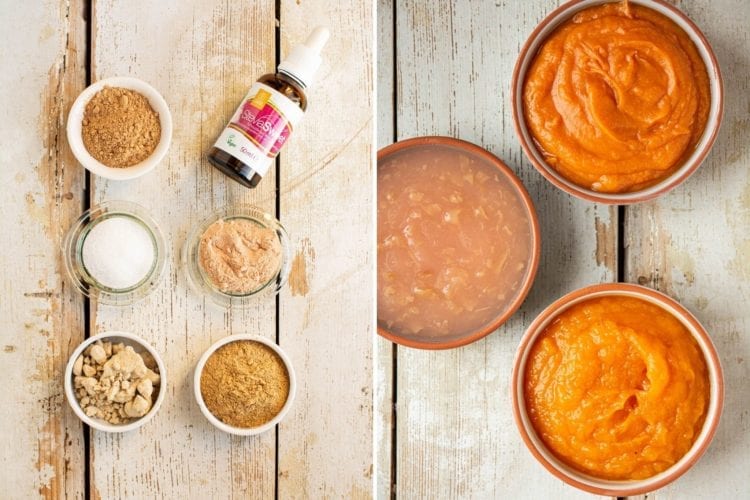













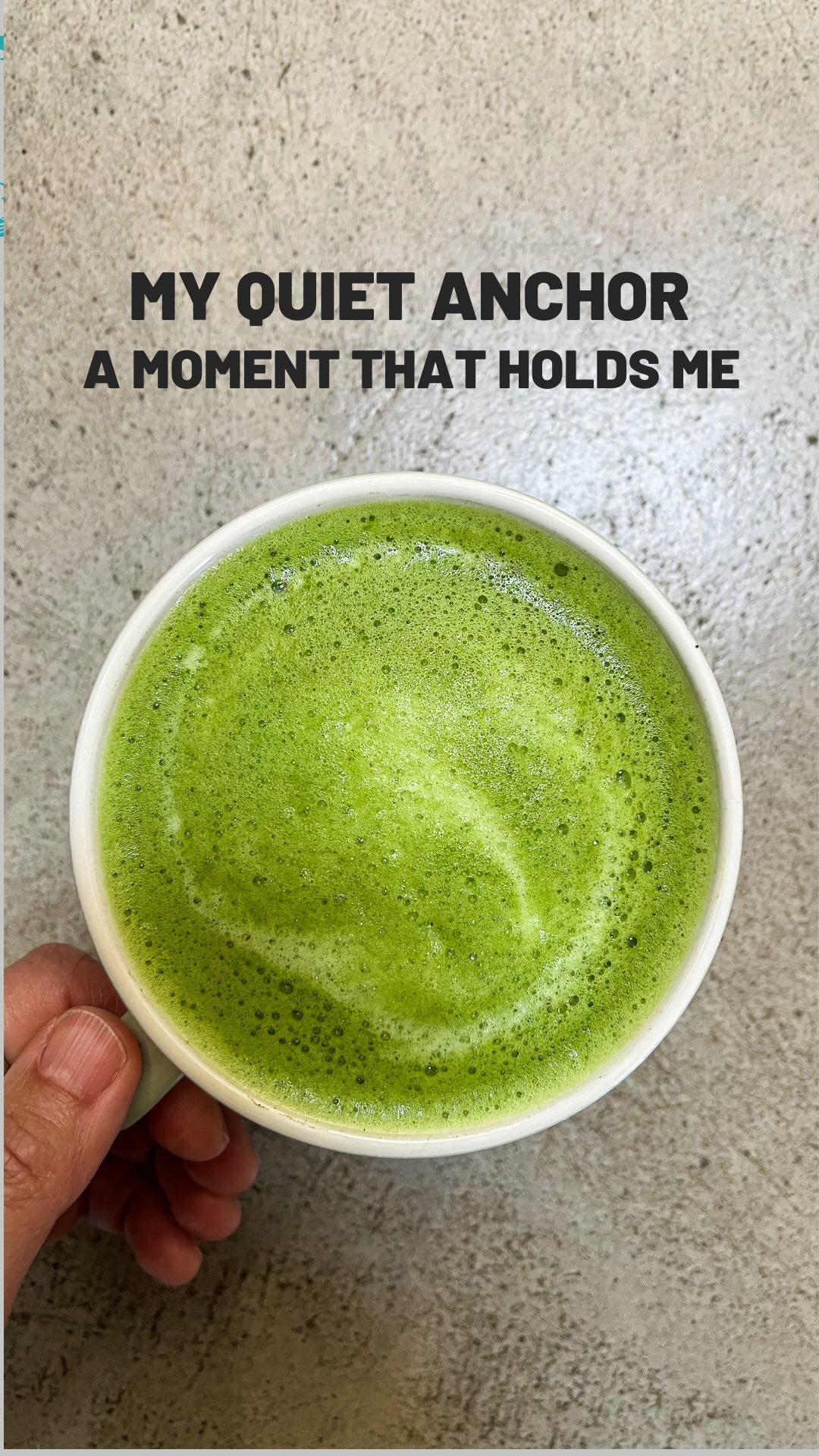











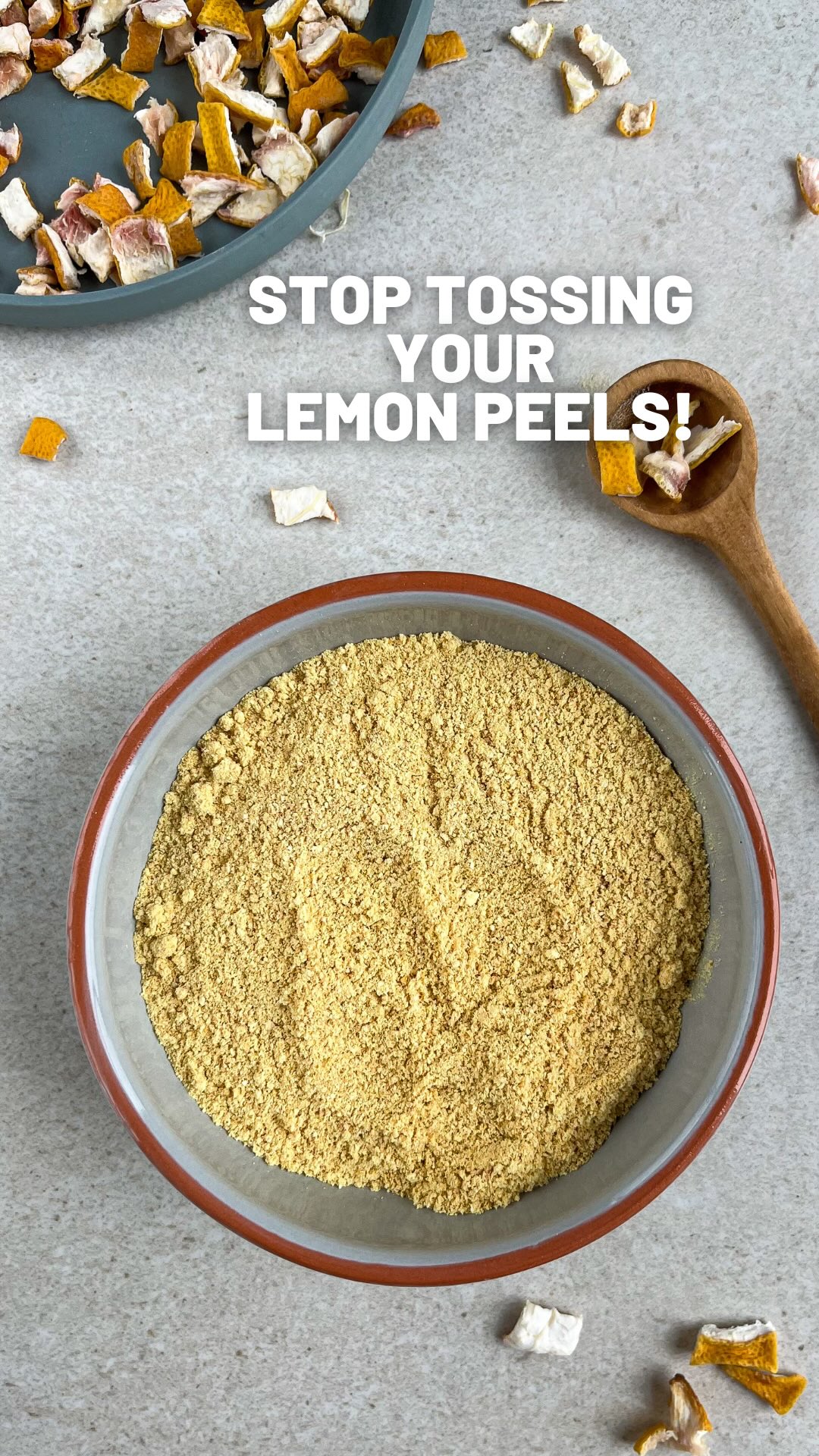

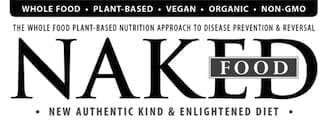





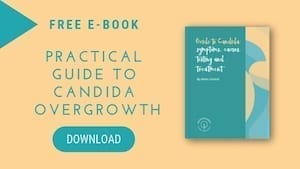

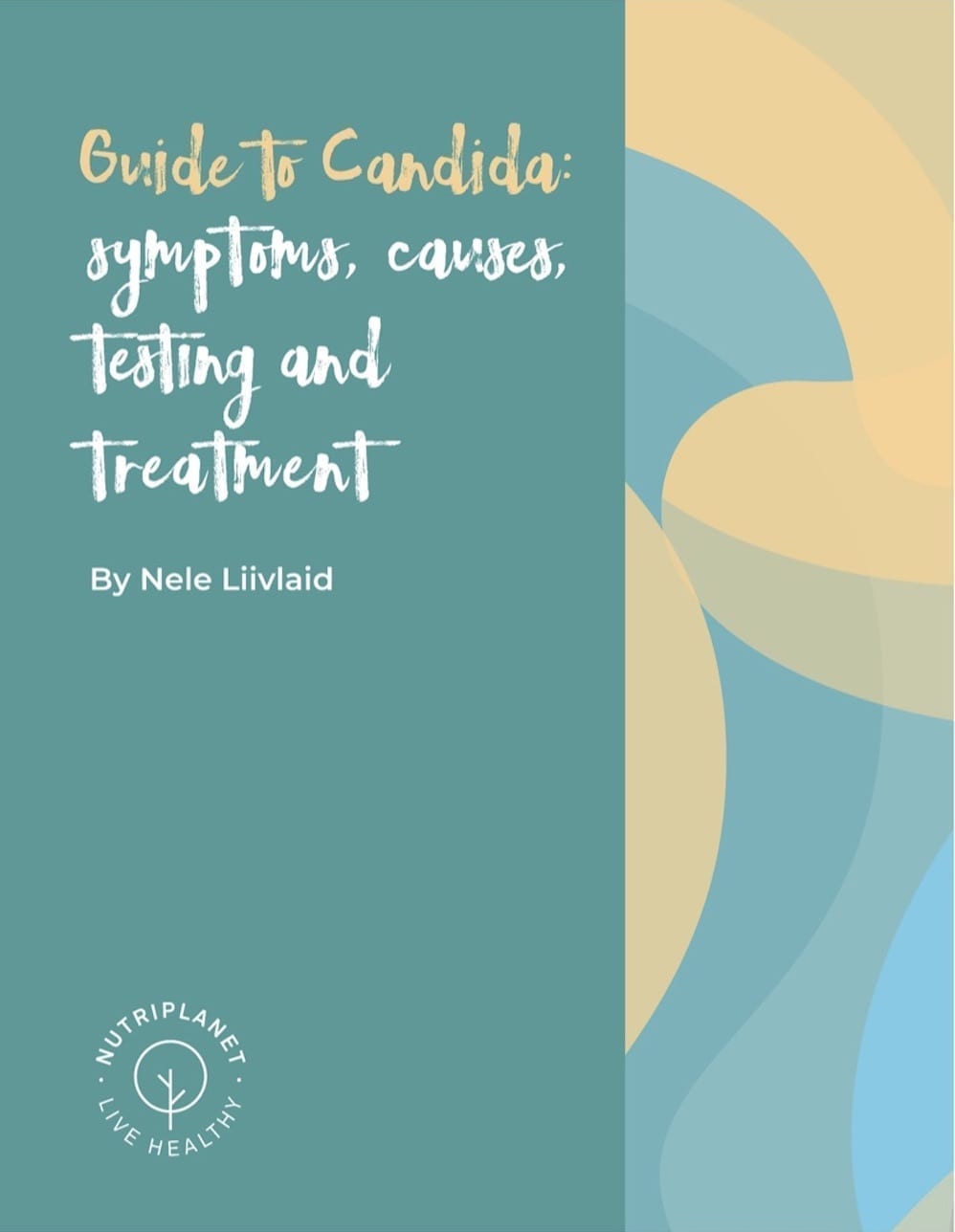
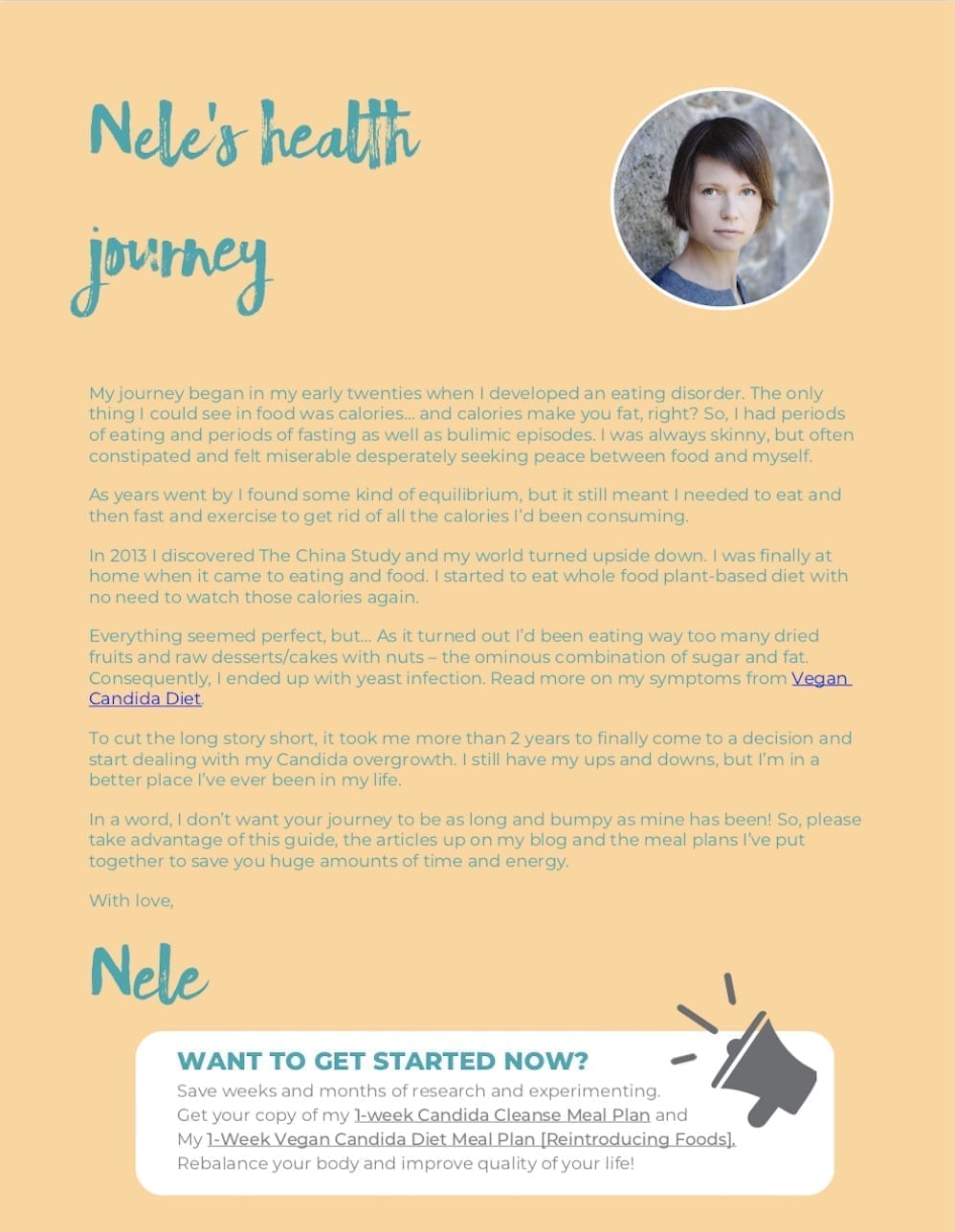
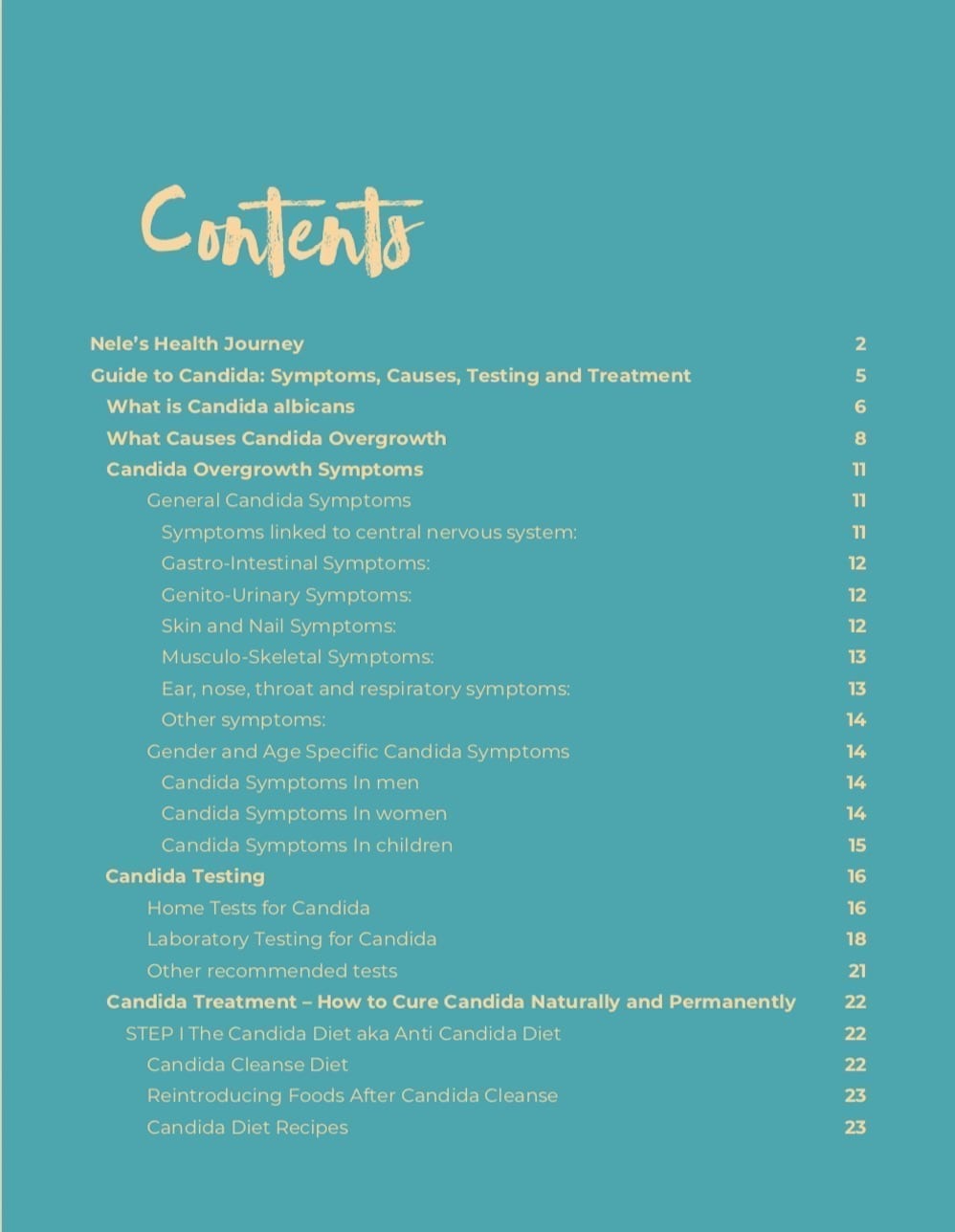
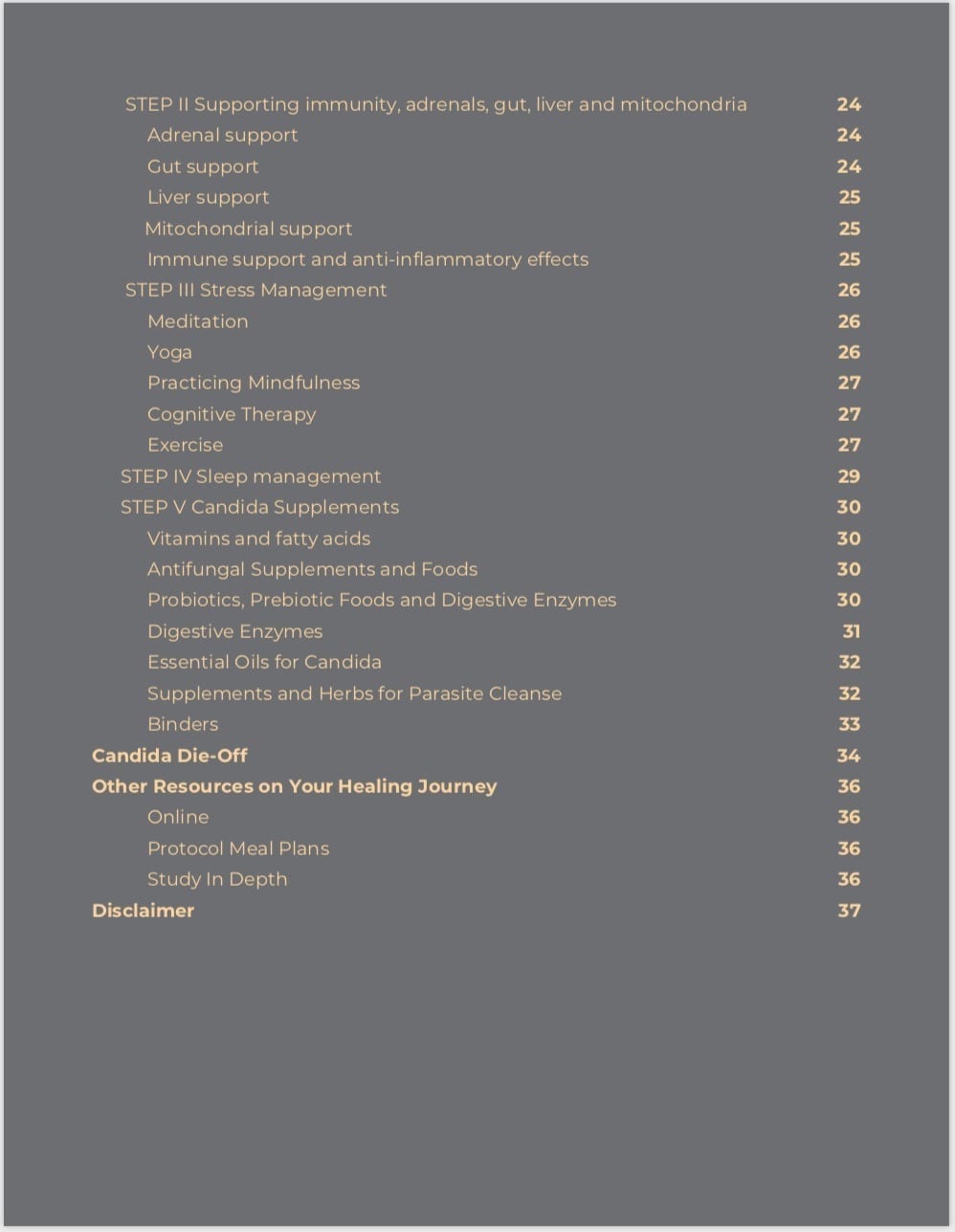
I stick the straw I use to drink my hot coffee in monk fruit & it’s more than enough to sweeten coffee. I just blow in the straw & stir to make sweetener dissolve. I’m prediabetic & this allows me to have healthy sugar substitute. Do you know whether allulose can be used as sweetener with candida diet?
Hi! Allulose doesn’t seem to spike glucose or insulin levels. However, I’d recommend using any sweeteners (that are not whole food) sparingly.
Thanks so much for the information! I’ve been racking my mind to come up with ways to satisfy my sweet tooth on the candida cleanse. I’m so encouraged to hear my taste buds will adjust in a couple weeks. I really appreciate what you have done. You’re a gem.
I’m so happy to hear that you found it useful! 🤗